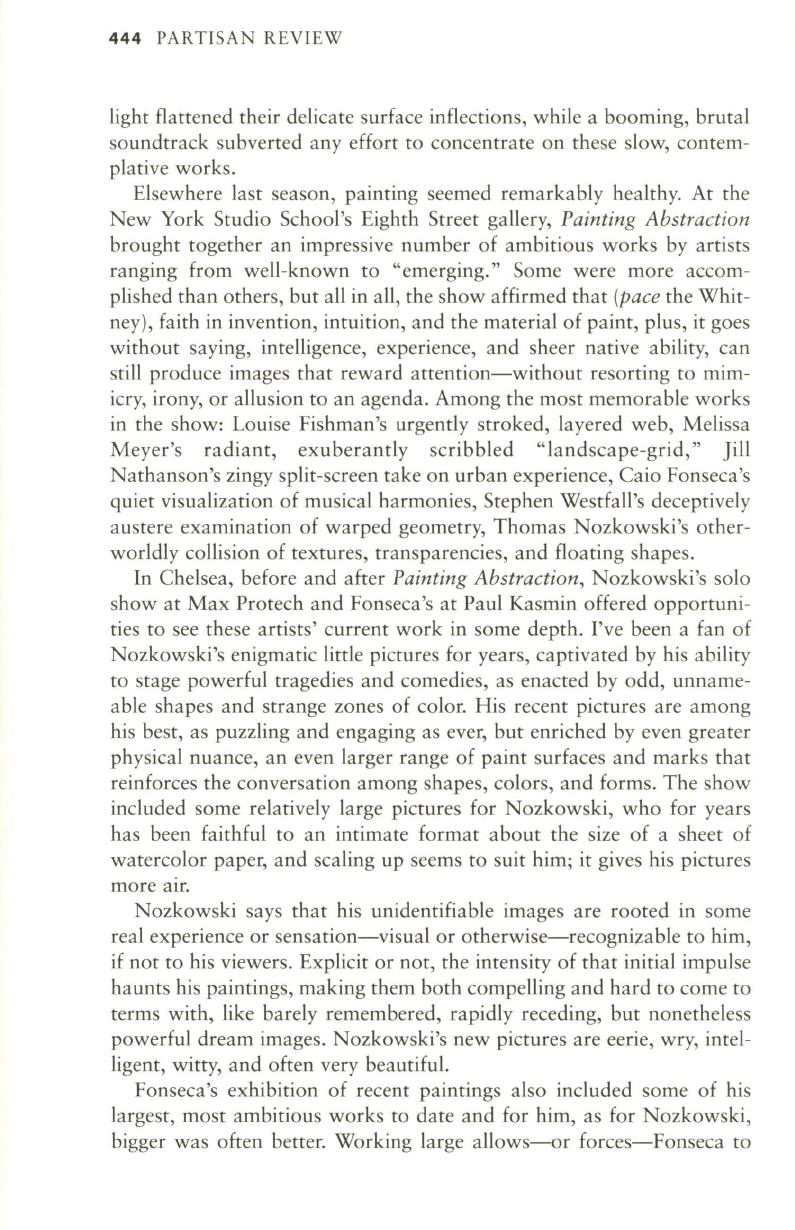
444
PARTISAN REVIEW
light flattened their delicate surface inflections, while a booming, brutal
soundtrack subverted any effort to concentrate on these slow, contem–
plative works.
Elsewhere last season, painting seemed remarkably healthy. At the
New York Studio School's Eighth Street gallery,
Painting Abstraction
brought together an impressive number of ambitious works by artists
ranging from well-known to "emerging." Some were more accom–
plished than others, but all in all, the show affirmed that
(pace
the Whit–
ney), faith in invention, intuition, and the material of paint, plus, it goes
without saying, intelligence, experience, and sheer native ability, can
still produce images that reward attention-without resorting to mim–
icry, irony, or allusion
to
an agenda. Among the most memorable works
in the show: Louise Fishman's urgently stroked, layered web, Melissa
Meyer's radiant, exuberantly scribbled "landscape-grid," Jill
Nathanson's zingy split-screen take on urban experience, Caio Fonseca's
quiet visualization of musical harmonies, Stephen Westfall's deceptively
austere examination of warped geometry, Thomas Nozkowski's other–
worldly collision of textures, transparencies, and floating shapes.
In Chelsea, before and after
Painting Abstraction,
Nozkowski's solo
show at Max Protech and Fonseca's at Paul Kasmin offered opportuni–
ties
to
see these artists' current work in some depth. I've been a fan of
Nozkowski's enigmatic little pictures for years, captivated by his ability
to
stage powerful tragedies and comedies, as enacted by odd, unname–
able shapes and strange zones of color. His recent pictures are among
his best, as puzzling and engaging as ever, but enriched by even greater
physical nuance, an even larger range of paint surfaces and marks that
reinforces the conversation among shapes, colors, and forms . The show
included some relatively large pictures for Nozkowski, who for years
has been faithful to an intimate format about the size of a sheet of
watercolor paper, and scaling up seems to suit him; it gives his pictures
more air.
Nozkowski says that his unidentifiable images are rooted in some
real experience or sensation-visual or otherwise-recognizable
to
him,
if not
to
his viewers. Explicit or not, the intensity of that initial impulse
haunts his paintings, making them both compelling and hard
to
come
to
terms with, like barely remembered, rapidly receding, but nonetheless
powerful dream images. Nozkowski's new pictures are eerie, wry, intel–
ligent, witty, and often very beautiful.
Fonseca's exhibition of recent paintings also included some of his
largest, most ambitious works to date and for him, as for Nozkowski,
bigger was often better. Working large allows-or forces-Fonseca
to


